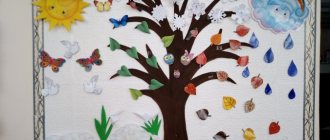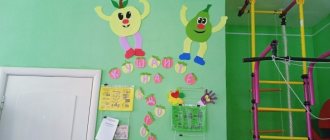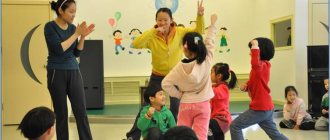What is a subject-development environment in a preschool educational institution?
Svetlana Primachenko
What is a subject-development environment in a preschool educational institution?
What is a subject-development environment?
A subject-development environment is a set of material objects for the development of a child, subject-specific and social means of ensuring various types of activities for pupils. It is necessary so that children can grow fully and get acquainted with the world around them, be able to interact with it and learn independence. The concept of a subject-development environment It promotes the development of independence, initiative and gives children the opportunity to realize the abilities that they have. A subject-development environment improves the child’s experience of emotional and practical interaction with people around him, and also helps to increase the cognitive activity of all children in the group. It consists of: a large playground; gaming equipment; toys; different types of gaming paraphernalia; gaming materials. These funds must be located in a special room, hall or in the courtyard of the kindergarten. How is a developmental environment ? During this stage, it must be remembered that the subject-development environment should give room for the development of educational, nurturing, stimulating and communicative functions. The most important task is the desire to increase the child’s independence and initiative. Such an environment should be spacious and pleasant for children, satisfying their needs and interests. objects and their shape are also important : they must be safety-oriented and appropriate for the age of preschoolers. Creating a subject-specific development environment includes an important aspect: changing decorative elements, as well as allocating places in each group for children’s experimental activities. The color palette should be based on warm pastel colors so that the atmosphere is light and does not “pressure”
on pupils.
As for the subject-developmental environment of the group , changes should occur in it depending on the age of the children, their characteristics, the period of study and, naturally, the educational program. A developing subject-spatial environment must be open in nature, subject to adjustment and development, and not be a closed system. It’s good if it is regularly updated and meets the current needs of the children. In any case and under different circumstances, the space around the kids must be replenished and updated in accordance with the requirements for a certain age of the child. Based on this, when creating this environment for any age groups in a preschool educational institution, it is imperative to take into account the psychological factors of interaction between participants in the educational process and the general atmosphere, including the design of the preschool institution. The principle of positions in interaction It is based on the organization of space for communication between parents and teachers with children. It is quite well known that confidential conversations and open communication between adults and children are carried out on the basis of the principle of spatial communication “eye to eye”
.
An appropriate subject-development environment will provide an opportunity to bring children and adults closer together and equalize their positions. It would be appropriate to use a variety of furniture, namely corners, podiums and slides. The principle of activity It makes it possible for an adult and a child to jointly participate in activities to create an environment that will easily transform and change. You can equip group rooms with workshops, sand and water centers using screens. When organizing general activities, it is necessary to select materials that have the ability to enhance cognitive activity. They can be technical devices, magnets, toys, magnifying glasses, springs, beakers, models, scales, and you can also provide various natural materials for experimentation and study. Principle of stability-dynamism This principle promotes the creation of conditions that can be changed in accordance with the mood, preferences and capabilities of children. Playrooms for different age groups are needed, and a stability zone needs to be created for kids. subject-spatial environment must be properly equipped . The preschool educational institution must ensure that there are toys, furniture, storage containers, podiums for relaxation, as well as prefabricated structures. This room should be filled with a variety of objects and also have a lot of free space. You can create themed areas, install upholstered furniture and make it part of the playroom.
Technology for building a developmental environment in preschool educational institutions (group) on the topic
Technology for building a developmental environment in preschool educational institutions
Maintaining
“Education is not the sum of events and techniques,
and the wise treatment of an adult with the living soul of a child"
V. A. Sukhomlinsky
In the modern sociocultural situation, education is being given increasing importance in the development of society and improving the quality of life. Education today is a special value in the world community.
Russia's new educational policy is based on the desire to place education among the main national priorities. Accessibility, quality, and efficiency of education determine the general vector of its development. The action plan includes modernization of the content and delivery mechanisms of education.
One of the central ideas of the new educational situation was the recognition of the humanistic paradigm of education, reorientation towards human values, and the formation of him as a subject not only of educational activities, but also of culture. In this regard, considerable attention is paid to personality-oriented education as a special means of revealing the essential strengths of a person, his abilities, and finding his place in the space of culture.
Research in recent years devoted to the problems of childhood shows a qualitatively different understanding of the essence of childhood and attitude towards it as a cultural-historical, socio-psychological, socio-pedagogical phenomenon. An approach to the problem of the development of a growing person as an individual is substantiated on the basis of the concept of “social development in the space-time of childhood” (D.I. Feldstein), the cultural creative function of childhood in the development of society is explored (V.T. Kudryavtsev), and the representation of symbols in the minds of children is studied world order (Yu.A. Aksenova).
The formation of such a perception of childhood in modern science requires a qualitative rethinking of not only the content side of the conditions of socialization of the child, but also the forms in which it is carried out, i.e. the educational environment itself.
The approval of educational priorities at the stage of preschool childhood poses the need to study the possibilities of transforming the old organizational form that ensures the social development of the child (which is a preschool educational institution) into a new one that corresponds to the potential of childhood and the development needs of modern society.
The concept of the educational environment has been developed over the past decades by scientists both in our country and abroad. The study of the educational environment is carried out from a position related to the modern understanding of education as a special sphere of social life, and the environment as a factor in education.
The main general educational program of preschool education determines the content and organization of the educational process for preschool children and is aimed at the formation of a general culture, the development of physical, intellectual and personal qualities, the formation of prerequisites for educational activities that ensure social success, the preservation and strengthening of the health of preschool children, the correction of deficiencies in physical and (or) mental development of children. In accordance with this, the educational environment of preschool children should be organized.
In a broad context, the developmental educational environment is a sociocultural space within which the process of personal development occurs spontaneously or with varying degrees of organization.
From the standpoint of the psychological context, the developmental environment is a certain ordered educational space in which developmental learning is carried out (L.S. Vygotsky, P.Ya. Galperin, V.V. Davydov, L.V. Zankov, A.N. Leontiev, D. B. Elkonin and others).
In preschool pedagogy, the term “developmental environment” is understood as “a complex of material and technical, sanitary and hygienic, ergonomic, aesthetic, psychological and pedagogical conditions that ensure the organization of the lives of children and adults” (S.A. Smirnov).
The quality of education in preschool educational institutions is considered at the present stage as the quality of conditions, the quality of the educational process, and the quality of results. In this aspect, a special place is occupied by the developing environment (the world of nature and people, the subject-spatial environment).
A subject-development environment is an organized living space that can ensure the socio-cultural development of a preschooler, satisfy the needs of the child’s current and immediate creative development, and the formation of his abilities.
Conducted scientific research (S.L. Novoselova) has confirmed that enriching the subject and social conditions of a child’s activity leads to the enrichment of his consciousness and the psychological content of the activity. A child becomes “more capable” if he has the opportunity to constantly improve his methods of action in the socio-subject environment.
A necessary condition for achieving success in creating a favorable, psychologically comfortable developmental environment is the purposeful, coordinated and coordinated activity of all members of the teaching staff, the acceptance by each employee of the goals and objectives of the work on organizing a subject-specific developmental environment. At the same time, the main resources for improving the quality of education in a preschool educational institution are team organization of work, professional and personal growth of employees, and the head of the preschool educational institution.
Goals of creating a developmental environment in preschool educational institutions:
- ensuring the vital needs of the developing personality of a preschooler: vital (organic vital needs), social, spiritual.
- ensuring the socio-cultural development of preschoolers;
- promoting the development of the child as a person;
- improving the pedagogical process by increasing the developmental effect of the educational environment;
- meeting the needs of the child’s current and immediate creative development.
Tasks:
- provide a sense of mental security, the child’s trust in the world, the joy of existence;
- organize a subject-development environment that ensures the creative activity of each child and the development of his abilities;
- develop the child’s individuality;
- promote the activity and fullest realization of the child;
- form the basis of personal culture;
Characteristics of the principles of constructing a preschool educational environment that develops the child’s personality
| Name of principles | Brief description of the principles |
| Development principle |
|
| The principle of nature-conformity of education |
|
| The principle of psychological comfort |
|
| Principle of interaction |
|
| The principle of trusting cooperation |
|
| The principle of dialogic communication |
|
| The principle of mutual developmental influence of teacher and child |
|
| The principle of non-violence in education |
|
| The principle of priority for the development of the child’s personal and semantic sphere |
|
| The cultural-activity principle |
|
| Principle of activity learning |
|
| The principle of priority of public preschool education |
|
| The principle of continuity of education |
|
| Health-saving principle |
|
The role of the subject-development environment in ensuring the processes of self-development of a preschooler’s personality is to promote the formation of personality, provide a sense of psychological security, and develop the child’s individuality, while representing “a single complex of kinesthetic and audiovisual modalities” (L.P. Strelkova), influencing the self-realization of the individual.
Functions of the subject-spatial environment in relation to the personality of a preschooler:
- Information content of the environment. It is a means of transmitting social experience (since every object carries certain information about the world around it).
- Expanding the “technical horizons” of preschoolers with surrounding objects (O.V. Artamonova), providing artistic perception, opening up the world of music and art.
- The world of the objective environment as a source of knowledge of the inner world of an adult, his personal and business qualities.
- The subject-spatial environment, influencing the emotional world of the child, encourages him to activity and puts him in an active cognitive position.







